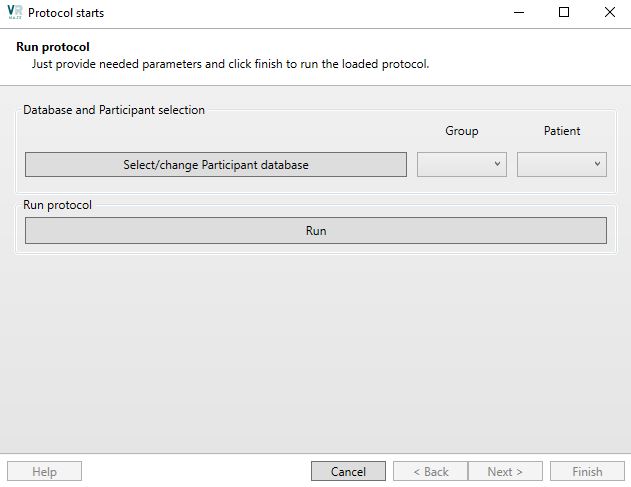Launch a protocol

There are 3 modes of running the protocol from the main GUI:
- The protocol test
- Protocol operation
- Local protocol test - accessible from the main toolbar and context menus.
Protocol test
The protocol test allows you to run the protocol completely without providing any participant information or output result file. It is an instantaneous execution.
Protocol test
The protocol test will run the protocol in the same manner as a conventional run. All the elements of the protocol will be taken into account, as well as the pre-protocol and post-protocol commands (Cave Protocol)
Participant ID
During a test, the registered participant ID is "-1".
Output file
During a test, the output file is named OutputTest.xml and is stored in the Backup folder of the data folder. It is therefore possible to check the test output.
Local protocol test
The local protocol test allows to test only one sequence of a protocol without testing the rest. The content of the test depends on the node on which it is run. If it has a parent test, then only the test will be run, if it has no test, but has a parent experiment, the whole experiment will be run.
Accessibility of the local test
The local test is available via the context menu of the selected node or the main toolbar.
Executed Protocol
The executed protocol file is named ProtocolTest.xml and is stored in the Backup folder of the data folder. It does not contain the complete protocol, only the part to be executed.
Exploitation of protocols
The local tests and tests allow you to quickly launch a protocol without having to enter a participant identifier. These features are useful when designing a protocol. For the exploitation of a protocol, it is possible to launch the protocol by indicating a certain amount of additional information.

Unlike test launches, protocol exploitation offers you a run configuration window. In this window, it is necessary to fill in a participant and an output result file name. Clicking on the button for selecting the participant database allows to load the database and to fill in the groups and participants, allowing the operator to choose his participant.
Clicking the "Run" button will open a window allowing the operator to choose the name and location to store the run result before the instant run is launched.
Participant database
To run a protocol, you need at least a participant database with at least one registered participant. If no participant is registered, the subject ID will be "-1".
File version and execution
You should be very careful with protocol files designed in older versions of the software. These protocols may not have all the new components and nodes from the current versions.
This will result in a default initialization of the missing nodes and components. This default initialization will necessarily apply a random identifier. It is therefore advisable to always load an old file and save it (to freeze its identifiers) before using it again.
Tip
When opening a protocol file designed in an old version, always remember to save it to freeze the identifiers of new components.